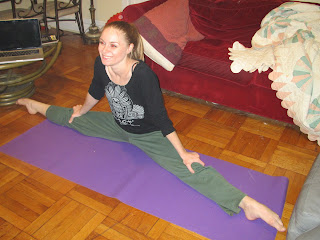When you memorize lines you have a script, when learning music you have a score, when learning dance you have...
Well - there is specific dance notation called
Labanotation , but it is both difficult to learn and read. In fact, most professional dancers have never learned labanotation. In ballet, you have a language, every step has a specific name, so you can write it down "tombe pas de bourree glisade grande jete," but most musical theatre/stage choreography uses movements without names. So what to do? Well, here are some ideas of what I do.
The BEST suggestion I can give you is to VIDEO your rehearsals. (or at least the final "run" of a piece of choreography in a rehearsal.) This allows you to go back and reference movements and counts similar to a score or a script. It also gives you an opportunity to evaluate yourself and see where you can improve. I will just bring my canon point and shoot camera to rehearsal and use the video function. I"ve seen people with flip recorders, cell phones, and video cameras. Whatever floats your boat. Two words of advice, sometimes the best angle you get is to record your reflection in the mirror rather than trying to record straight on, and most importantly, always always *ALWAYS* a
sk permission of everyone involved with the rehearsal. Sometimes people, for a variety of reasons, don't want to do video-ed and you need to respect their wishes.
With the video, I will often rent a studio, bring my laptop with the video on it, and rehearse alone. You can also rehearse in your living room, or the park, or a hidden corner of the rehearsal studio. If you start reviewing during rehearsal or on a break, you'll be pleasantly surprised how many people are in your same boat, and will join you to review.
So, if you can't video what do you do? If you can, assign every "section" a name and every step within a section a name. For example, you could have the "opening hoe-down section" "the drunk section" "the rhumba section" "the cheesey finale section." Within the "opening hoe-down section" you might assign names such as "thigh smacks, spit on hands, jump with heel clicks, 3 quick turns in place, clap, clap, clap, clap." The actual words don't matter so long as they make sense to YOU. You can also draw fun stick figures to help to help you remember what positions are. If the choreography goes along with words, you can write the steps/stick figures under the words in your score. If it's instrumental, I like to notate them vertically on a white piece of paper. If you are rhythmic, you can add counts to your image. Here is an example.

You can also make a birds-eye view of the stage, (or ask the stage manager for a set outline, they often have many copies for their own records, and make many copies for yourself.) Using this outline as a base, document your place on stage during choreography. You can write notations that make sense to you in the borders or on the opposite pages. You can document everyone's choreography, just your own, or just you and your dance partners. It's up to you. I suggest you highlight your "track" with either a different color or highlighter so it's easy to find when glimpsing at the pages. Also, find abbreviations for everyone's names or stage characters. Initials, letters, numbers, colors, all help. Here are five pages of documented choreography from THE WOMAN IN WHITE. I hope the powers that be won't mind me sharing the information with you as a learning tool. All of the choreography and staging is attributed to Trevor Nunn and Wayne McGregor.





What you can hopefully see in the above pictures is that on the top line of the page there is either a lyric or cue such as "Lammastide Entrances" "Winds of the Winter" (which is a lyric) and "Lammastide Dance Starting Positions" (which started the first section of the dance proper. There are letters that represent each character and where they stand, and arrows pointing the direction and course in which they move to their next position. At the bottom of the page are further notes about what is happening. (stage rotates, corn is passed to girl on "winds of the winter," "CDG and father break off," "Laura is now carrying Corn Dolly Doll," etc... Notate what you need to notate to help your own brain. You will notice one of the notations says "go to lines illustrated on page 3." What that means is, I made another page with information that didn't fit onto that choreography sheet more, which will need to be referred to at that point. Depending on what is needed, it could be a sheet like first one posted with stick figures and counts, or another birds eye view.
For the record, everyone develops their own style of writing track sheets. For example, the London dance captain of the same show wrote his track sheets like this: (which again I hope he doesn't mind me sharing as a learning tool.)
You know how your mind works, so embellish your notes where needed. If you need visuals, use more drawings, if you need words, create words, write paragraphs, etc... Your personal notations will develop with practice. There is no right or wrong, so you win no matter what you do!:)
Perhaps the most helpful thing to do is get together with your cast mates and review the choreography together before, after, and during rehearsals. Everyone will have different strengths and remember different sections of choreography. Your powers combined, you are expert sources of choreography. Also, don't be afraid of asking your dance captain (if there is one), director, or choreographer to review choreography with you! They are there to help and want you to succeed!

























